5/22/2009 to 6/16/2009
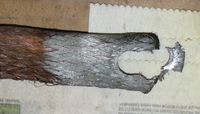 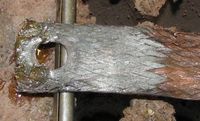 I found the missing bit of ground strap under the bolt I should have removed from the frame of the car. I cleaned this up and soldered it back in. I found the missing bit of ground strap under the bolt I should have removed from the frame of the car. I cleaned this up and soldered it back in. |
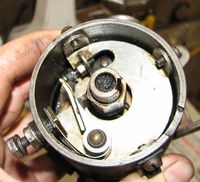 Time for the easiest points adjustment ever. Usually I am trying to do this hanging head-down in the engine bay while laying on the fender. Time for the easiest points adjustment ever. Usually I am trying to do this hanging head-down in the engine bay while laying on the fender. |
 Ignition wrenches and feeler gauges are something that I used to use a lot more than I do now. The second distributor in the background is a NOS distributor I have. I was using it here to check that mine was assembled correctly. Ignition wrenches and feeler gauges are something that I used to use a lot more than I do now. The second distributor in the background is a NOS distributor I have. I was using it here to check that mine was assembled correctly. |
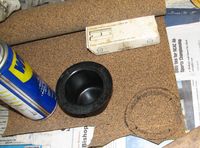 Need another gasket for the starter drive cover (that metal bit in the picture). I used grease to mark the cork then cut the gasket Need another gasket for the starter drive cover (that metal bit in the picture). I used grease to mark the cork then cut the gasket |
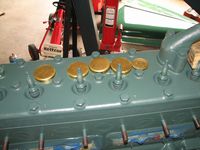  Time to install the freeze plugs. Nice big brass ones. I also installed the oil dipstick tube with a 2×4. I think it looks pretty cool Time to install the freeze plugs. Nice big brass ones. I also installed the oil dipstick tube with a 2×4. I think it looks pretty cool |
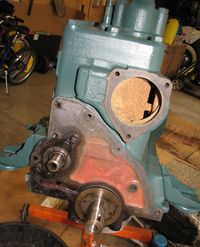 The front plate goes on next. Here is the front of the engine with all the masking removed and the gasket surface clean. This gasket is a bit tricky to install because there are a lot of moving parts. The oil pan filler block, engine timing cover, and front plate all share this gasket and/or its mounting holes. The front plate goes on next. Here is the front of the engine with all the masking removed and the gasket surface clean. This gasket is a bit tricky to install because there are a lot of moving parts. The oil pan filler block, engine timing cover, and front plate all share this gasket and/or its mounting holes. |
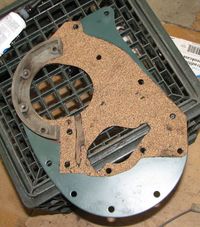 I decided (probably incorrectly) that the best technique was to glue the gasket to the front plate first. I used a tube of Chrysler RTV left over from a transmission oil change. That might be overkill but I don’t want this sucker to leak. I used the oil pan filler block (that silver ‘C’ shaped part) and a couple of bolts to hold the gasket in position then put a weighted board on top until the RTV set up. I decided (probably incorrectly) that the best technique was to glue the gasket to the front plate first. I used a tube of Chrysler RTV left over from a transmission oil change. That might be overkill but I don’t want this sucker to leak. I used the oil pan filler block (that silver ‘C’ shaped part) and a couple of bolts to hold the gasket in position then put a weighted board on top until the RTV set up. |
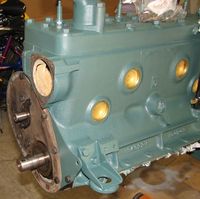 Then leaving the filler block in place I put RTV all over the sealing surface on the front of the block and bolted the front plate on. To make sure the gasket is compressed evenly I used oil pan bolts temporarily in the holes that will be used to hold the timing cover on. Oil pan bolts were perfect for this because they were short enough to not bottom out in the holes Then leaving the filler block in place I put RTV all over the sealing surface on the front of the block and bolted the front plate on. To make sure the gasket is compressed evenly I used oil pan bolts temporarily in the holes that will be used to hold the timing cover on. Oil pan bolts were perfect for this because they were short enough to not bottom out in the holes |
 Now it is time for the cam gear. You don’t want to tap on the cam or crank bearings so I used a bolt and an motley assortment of hardware I had laying around the garage to pull the gear on. I lubed everything with engine oil first. Finally I put the cam gear bolt in with a little blue Loctite for insurance. Now it is time for the cam gear. You don’t want to tap on the cam or crank bearings so I used a bolt and an motley assortment of hardware I had laying around the garage to pull the gear on. I lubed everything with engine oil first. Finally I put the cam gear bolt in with a little blue Loctite for insurance. |
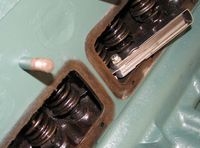 With the gear on I had a nice handle to turn the cam. So I adjusted the valves to the factory spec of .016″. Most were pretty close but about 3 were too tight. That seems odd because I would have expected them to be too loose from wear. Adjusting the valves is very easy with the engine out. The hardest part was finding TWO 1/2″ open end wrenches. With the gear on I had a nice handle to turn the cam. So I adjusted the valves to the factory spec of .016″. Most were pretty close but about 3 were too tight. That seems odd because I would have expected them to be too loose from wear. Adjusting the valves is very easy with the engine out. The hardest part was finding TWO 1/2″ open end wrenches. |
 Installed the valve covers and vent tube. The vent will have to come off again to get the starter in. I also need to make, buy, or steal a gasket for the vent tube. Installed the valve covers and vent tube. The vent will have to come off again to get the starter in. I also need to make, buy, or steal a gasket for the vent tube. |
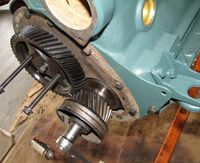 Now that I am done flipping the cam around I can put the crank timing gear on. The blue line highlights the timing marks on the gears. As before I used whatever came to hand to pull the gear onto the crank. However this time I did not have a long bolt in the right size for the crankshaft so I had to use the short factory bolt and make lots of adjustments. At this point I was using an old accessory belt idler pulley for a Chrysler minivan to move the gear another 1/4″ Now that I am done flipping the cam around I can put the crank timing gear on. The blue line highlights the timing marks on the gears. As before I used whatever came to hand to pull the gear onto the crank. However this time I did not have a long bolt in the right size for the crankshaft so I had to use the short factory bolt and make lots of adjustments. At this point I was using an old accessory belt idler pulley for a Chrysler minivan to move the gear another 1/4″ |
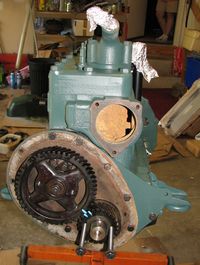 All timed up and ready to go. I used the two bolts and a big screwdriver to keep things from moving while I worked. You can see the timing mark on the cam is right between the two timing marks on the crank gear. This means the cam is timed and the engine is at top dead center (TDC). All timed up and ready to go. I used the two bolts and a big screwdriver to keep things from moving while I worked. You can see the timing mark on the cam is right between the two timing marks on the crank gear. This means the cam is timed and the engine is at top dead center (TDC). |
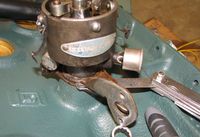 Time for the distributor to go in. To allow the vacuum advance to rotate the distributor there needs to be a .020″ gap between the vacuum advance mount and the arm on the distributor. Here I am setting that gap. Time for the distributor to go in. To allow the vacuum advance to rotate the distributor there needs to be a .020″ gap between the vacuum advance mount and the arm on the distributor. Here I am setting that gap. |
 I highlighted the ignition timing mark on the flywheel with a little yellow paint to make timing easier. I highlighted the ignition timing mark on the flywheel with a little yellow paint to make timing easier. |
 Here the oil pickup tube is installed and I have started laying out the oil pan gaskets. I put bolts in some of the holes to help locate everything. It is no wonder Studebaker’s had lots of oil leaks. This gasket is in 4 parts (5 if you count the front plate gasket) and all have to be sealed to the block, the pan, and each other to prevent leaks. This is a challenge even with modern sealants. I can’t imagine trying to do this without RTV. Here the oil pickup tube is installed and I have started laying out the oil pan gaskets. I put bolts in some of the holes to help locate everything. It is no wonder Studebaker’s had lots of oil leaks. This gasket is in 4 parts (5 if you count the front plate gasket) and all have to be sealed to the block, the pan, and each other to prevent leaks. This is a challenge even with modern sealants. I can’t imagine trying to do this without RTV. |
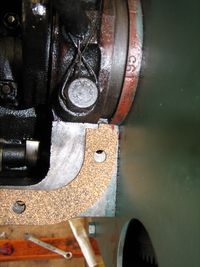 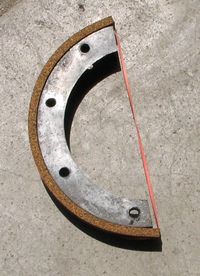  Most of the gaskets I got for this engine fit well. This one does not fit well at all. As you can see on the left the tab is too wide to fit into the grove on the rear bearing block. As is the cork strip that is supposed to fill that groove. And the gasket for the front filler block is both too long and too wide. And how the hell do I hold these fat bits of cork in place while the pan is installed? Most of the gaskets I got for this engine fit well. This one does not fit well at all. As you can see on the left the tab is too wide to fit into the grove on the rear bearing block. As is the cork strip that is supposed to fill that groove. And the gasket for the front filler block is both too long and too wide. And how the hell do I hold these fat bits of cork in place while the pan is installed? |
 That is a bit better. I trimmed the side gaskets to fit correctly and now the holes almost line up. I think this will be a three step process. First I will glue the side gaskets to the block and use the oil pan to clamp them down while the RTV sets. Next I will trim and glue the two end gaskets to the front plate and rear bearing block. I will have to figure out how to hold them in position while the RTV sets up. Finally I will RTV the oil pan to the block and gasket. That is a bit better. I trimmed the side gaskets to fit correctly and now the holes almost line up. I think this will be a three step process. First I will glue the side gaskets to the block and use the oil pan to clamp them down while the RTV sets. Next I will trim and glue the two end gaskets to the front plate and rear bearing block. I will have to figure out how to hold them in position while the RTV sets up. Finally I will RTV the oil pan to the block and gasket. |
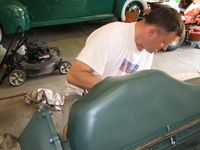  Step one is done. I put a generous smear of RTV on the block and stuck the side gaskets on. Any that gets squeezed out I can clean up later. Here I am frantically trying to install the bolts before the RTV sets. On the right you can see the result. The front filler block is installed but without the cork block there is a huge gap at the front of the pan. What a train-wreck of a design. Step one is done. I put a generous smear of RTV on the block and stuck the side gaskets on. Any that gets squeezed out I can clean up later. Here I am frantically trying to install the bolts before the RTV sets. On the right you can see the result. The front filler block is installed but without the cork block there is a huge gap at the front of the pan. What a train-wreck of a design. |
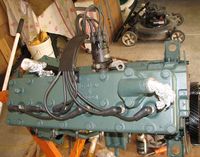 While waiting on the glue I cleaned and installed the spark plugs, wires, rotor, cap, and wire guide. This is starting to look like an engine again. While waiting on the glue I cleaned and installed the spark plugs, wires, rotor, cap, and wire guide. This is starting to look like an engine again. |
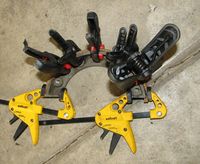 With the side gaskets on the oil pan glued down it is time to get the big cork block glued to the front filler block. RTV and a lot of clamps should do the trick. I will trim the gasket after the RTV is solid. With the side gaskets on the oil pan glued down it is time to get the big cork block glued to the front filler block. RTV and a lot of clamps should do the trick. I will trim the gasket after the RTV is solid. |
 The rear gasket was even more fun. It was both too wide and too long so I had to sand it down until I could “guide” it into the slot using the thin spatula tool in the picture. Bolts and wood wedges are keeping the block in place. I also had to cut the cork to length and angle the ends to fit tightly against the side gaskets. When I was happy with the fit I RTV-ed it in place and clamped it down. The rear gasket was even more fun. It was both too wide and too long so I had to sand it down until I could “guide” it into the slot using the thin spatula tool in the picture. Bolts and wood wedges are keeping the block in place. I also had to cut the cork to length and angle the ends to fit tightly against the side gaskets. When I was happy with the fit I RTV-ed it in place and clamped it down. |
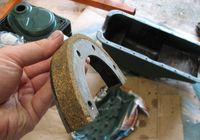 Here is the filler block gasket trimmed. Looks pretty nice. Here is the filler block gasket trimmed. Looks pretty nice. |
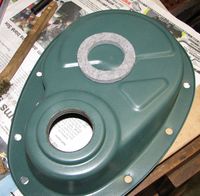 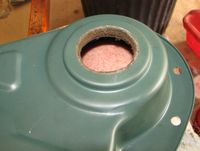 My gasket set came with a new timing cover oil seal. On the left you can see the old seal and the new one. The seal was a bit of a pain to wiggle into place but I managed to get it in there. The new seal is in the right picture. My gasket set came with a new timing cover oil seal. On the left you can see the old seal and the new one. The seal was a bit of a pain to wiggle into place but I managed to get it in there. The new seal is in the right picture. |
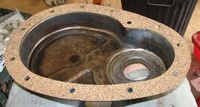 The front cover is next. This gasket fit perfectly. The front cover is next. This gasket fit perfectly. |
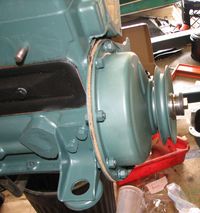 According to the manual we have to install the crank pulley before tightening the timing cover bolts. Here I have a long bolt and spacer pushing the pulley in. According to the manual we have to install the crank pulley before tightening the timing cover bolts. Here I have a long bolt and spacer pushing the pulley in. |
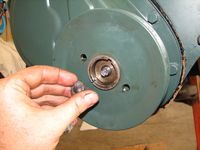 Then I blew it. For some reason I thought the crank pulley was supposed to be flush with the end of the crankshaft. So I zapped it with my impact wrench. Stupid stupid stupid. I ended up breaking off the factory bolt. Lucky for me I have another engine. Luckier still I was able to turn the end of the broken bolt out of the crank with my fingers. Then I blew it. For some reason I thought the crank pulley was supposed to be flush with the end of the crankshaft. So I zapped it with my impact wrench. Stupid stupid stupid. I ended up breaking off the factory bolt. Lucky for me I have another engine. Luckier still I was able to turn the end of the broken bolt out of the crank with my fingers. |
 That is better. Of course I ended up taking the pulley off again to install the oil pan. That is better. Of course I ended up taking the pulley off again to install the oil pan. |
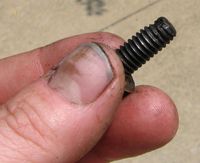 This water pump bolt has seen better days. It does not look like the hole goes into the water jacket but it sure looks like a a lot of water has been on this bolt. Maybe years of leaky water pumps. I replaced the bolt anyway. This water pump bolt has seen better days. It does not look like the hole goes into the water jacket but it sure looks like a a lot of water has been on this bolt. Maybe years of leaky water pumps. I replaced the bolt anyway. |
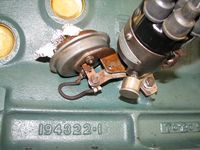 Vacuum advance is installed. I had to take the distributor loose to get it in. Vacuum advance is installed. I had to take the distributor loose to get it in. |
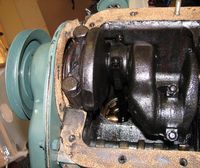 Ready to install the oil pan. This is going to be the tricky bit. The filler block and its gasket go on top of the side gaskets and against the front plate gasket. Lots of places to move and/or leak. I used the rest of my tube of RTV on the oil pan gasket. Ready to install the oil pan. This is going to be the tricky bit. The filler block and its gasket go on top of the side gaskets and against the front plate gasket. Lots of places to move and/or leak. I used the rest of my tube of RTV on the oil pan gasket. |
 Gee, did I use enough? I sure hope so. If this leaks again I will be very, very upset. Gee, did I use enough? I sure hope so. If this leaks again I will be very, very upset. |
 I noticed the valve covers were leaking just sitting on the stand. So I pulled the covers and found this. The “wet’ areas are oil. Obviously I did not use enough sealant on the stupid thing. In fact it looks like I hardly used any. I gave up and glued the suckers on with RTV. I noticed the valve covers were leaking just sitting on the stand. So I pulled the covers and found this. The “wet’ areas are oil. Obviously I did not use enough sealant on the stupid thing. In fact it looks like I hardly used any. I gave up and glued the suckers on with RTV. |
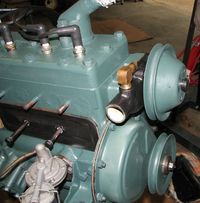 Water pump installed. The pulley is just stuck on there for fun. Water pump installed. The pulley is just stuck on there for fun. |
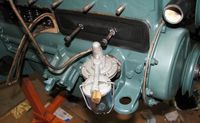 Fuel pump installed. Fuel pump installed. |
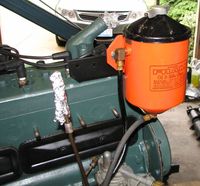 Oil filter installed. I just cleaned this up. It was installed about 25 years ago from a NOS kit so all the decals are perfect. Oil filter installed. I just cleaned this up. It was installed about 25 years ago from a NOS kit so all the decals are perfect. |
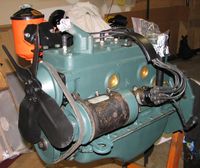 Generator, pulleys, belt, and fan are installed. I am not sure about my snazzy two-tone generator. If it bugs me I can always paint it better later. I used some blue Loctite on the fan bolts just to be safe. Generator, pulleys, belt, and fan are installed. I am not sure about my snazzy two-tone generator. If it bugs me I can always paint it better later. I used some blue Loctite on the fan bolts just to be safe. |
 Before installing the ground strap I sanded the area it mounts to down to bare metal. I will have to check to make really sure I have a good ground all over the engine. A bad ground is something to watch when everything is painted. Before installing the ground strap I sanded the area it mounts to down to bare metal. I will have to check to make really sure I have a good ground all over the engine. A bad ground is something to watch when everything is painted. |
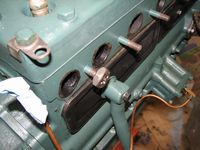 Before installing the manifold I ran a die over the studs to clean the threads. Lot of crud in there… Before installing the manifold I ran a die over the studs to clean the threads. Lot of crud in there… |
 Slip the gasket on. This is much easier with the engine out of the car! Slip the gasket on. This is much easier with the engine out of the car! |
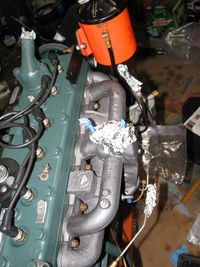 Manifold installed! I like the brass nuts. Now I can install all the oil, vacuum, and fuel lines that snake around the manifold. Manifold installed! I like the brass nuts. Now I can install all the oil, vacuum, and fuel lines that snake around the manifold. |
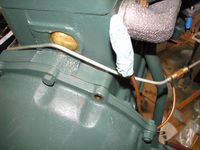 This is the return line from the oil filter. It drains oil from the filter can back into the dipstick tube. I replaced this before and routed the line over the engine. The problem with this is the line ran up and over the cylinder head. Since the head is higher than the bottom of the oil filter this kept the oil filter from draining (just like the way the s-drain in a toilet works). So I am going to try this routing. I made a bracket to hold the line. This might interfere with the gas pedal linkage. I can’t tell until the engine goes back in. [Update: Turns out it works just fine!] This is the return line from the oil filter. It drains oil from the filter can back into the dipstick tube. I replaced this before and routed the line over the engine. The problem with this is the line ran up and over the cylinder head. Since the head is higher than the bottom of the oil filter this kept the oil filter from draining (just like the way the s-drain in a toilet works). So I am going to try this routing. I made a bracket to hold the line. This might interfere with the gas pedal linkage. I can’t tell until the engine goes back in. [Update: Turns out it works just fine!] |
 To wrap up the engine assembly I installed the carburetor and all the oil and vacuum lines. Just for fun I polished all the copper lines then painted them with clear lacquer. They look really nice. I think the engine is ready to go! To wrap up the engine assembly I installed the carburetor and all the oil and vacuum lines. Just for fun I polished all the copper lines then painted them with clear lacquer. They look really nice. I think the engine is ready to go! |


Pingback: 2024 Fall maintenance | 1941 Studebaker Champion